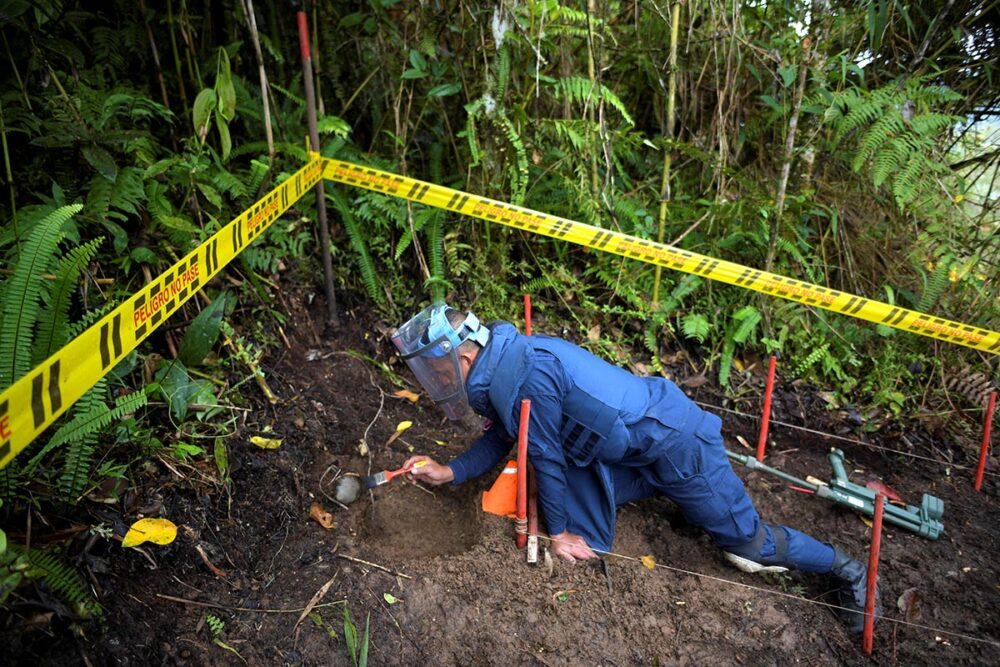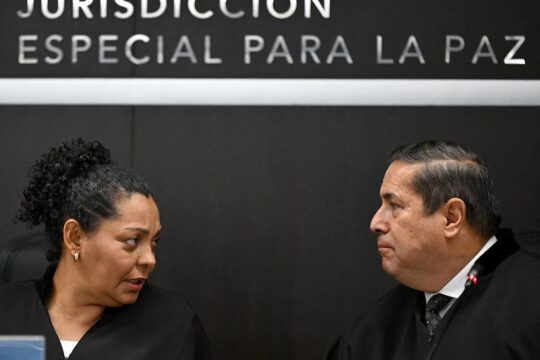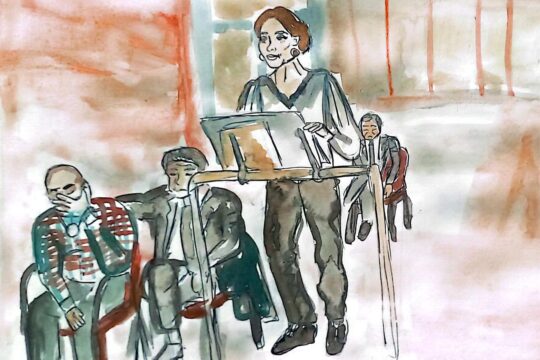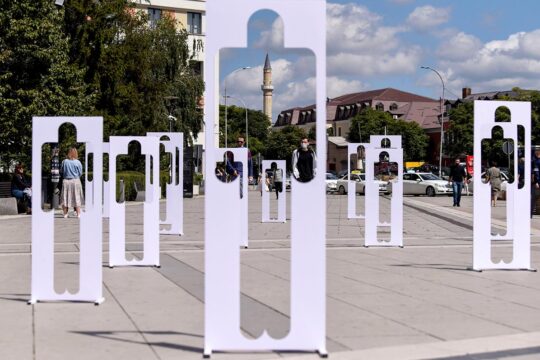“I will leave forgiveness up to God, but what I can tell you right now is that this work you did here means a lot to us”, a victim tells a perpetrator in the central cemetery in Palmira, Valle del Cauca, in the south of Colombia. Another victim, also part of the civil society organisation Corporación para el Desarrollo Regional, hands another perpetrator a flower: “I am grateful to finally have a place to mourn my son, although his body was not found here”, she says. These victims handing flowers to perpetrators were part of a nearly two-year long restorative project together with two other Colombian NGOs – the Corporación Humanitaria Reencuentros and Fundación Comité de Reconciliación ONG – representing individuals charged for war crimes and crimes against humanity before the Special Jurisdiction for Peace (JEP), the accountability mechanism of the 2016 peace agreement between the Colombian government and the Revolutionary Armed Forces of Colombia (FARC).
These initiatives, promoted by civil society organizations, are known as “Trabajos, obras y actividades con contenido reparador-restaurador” [Projects, works and activities with reparative-restorative content]. They are the most visible examples of the JEP’s pioneering justice model that blends restorative and criminal elements. Although the details are still worryingly unclear, participation in these projects will be taken into account in sentencing in the 11 macro-cases that the JEP has currently opened.
What are restorative projects?
The JEP can impose three types of sanctions on defendants. Former members of security forces, FARC, state agents or third parties to the conflict can receive ordinary sanctions of 15 to 20 years, alternative sanctions of 5 to 8 years, and own sanctions of 5 to 8 years that include restorative activities when JEP magistrates conclude that they had a determining role in the crimes. Sanctions of up to 5 years are reserved for perpetrators with lesser participation in the crimes.
Access to the latter two types of sanctions is predicated on the conditionality regime, which entails defendants’ full disclosure of the truthabout their participation and acknowledgement of responsibility in the crimes before the JEP. Further, the own sanctions, which involve no deprivation of liberty, also require that its participants take initiative for and carry out restorative projects. Such initiatives aim to balance restorative justice with criminal accountability by guaranteeing non-repetition, repairing harm, and strengthening social ties by emphasizing dialogue, victim participation, and community benefit.
When the JEP began operations in November 2018, the expectation was that its magistrates would impose restorative activities at the end of the trials, but some organizations have already been piloting projects and submitting them to the JEP for validation. They do so in acknowledgement of the promises made by the 2016 final peace agreement to the Colombian society, and particularly to the victims, whose rights were at the centre of the negotiations.
The upcoming sentences in macro-case 01, which focuses on kidnappings, grave deprivation of liberty and other concurrent crimes committed by the FARC, and macro-case 03, which centers on homicides and disappearances of civilians presented by the security forces as deaths in combat, are widely regarded as a test cases for this legal innovation. The two first rulings of the JEP are now scheduled for Tuesday 16 September and Thursday 18 September.
The real but fragile promise of the JEP
Three exploratory restorative projects, across seven JEP pre-approved work areas, were implemented and validated by the JEP between 2023 and 2024. These projects show that the promise of meaningful outcomes for all those directly involved, and for the Colombian society more broadly, is real but fragile.
The emphasis one of these projects, called Horizontes Seguros [Safe Horizons] on anti-personal mine education, is reminiscent of the humanitarian demining undertaken by a joint team of FARC combatants and state security forces before signing the peace agreement. Horizontes Seguros was implemented by the Colombian campaign against mines (CCCM) and included eleven former FARC combatants and seven former members of the security forces, all currently on trial before the JEP. It combined practical training with direct reparative actions extended by these 18 defendants to 31 individual victims, including 15 people directly affected by landmines, and their communities in the Antioquia region in the north of Colombia.
The core of Horizontes Seguros were the 144 workshops offered by the defendants to communities on how to identify and avoid unexploded devices. All these elements created a social and emotional supportive context for restorative encounters and dialogues between victims and defendants, which, according to Juliana Valencia and Ralf Dillmann of CCCM, correlate to a higher sense of humanization and better restorative outcomes.
The transformation of the area of Palmira central cemetery, known as Patio del Olvido, is part of a larger initiative known as Nos juntamos para encontrarles [We came together to find them]. The JEP did not open a case on forced disappearances, which some, like Jhon León, the spokesperson for Reencuentros, believe to be a mistake given the magnitude of this practice in Colombia and the commitments of the peace agreement. But the restorative project in the Palmira central cemetery is included in macro-case 05, a ‘territorial’ case prioritizing crimes committed in roughly a dozen municipalities in the area surrounding Cali, including Palmira.
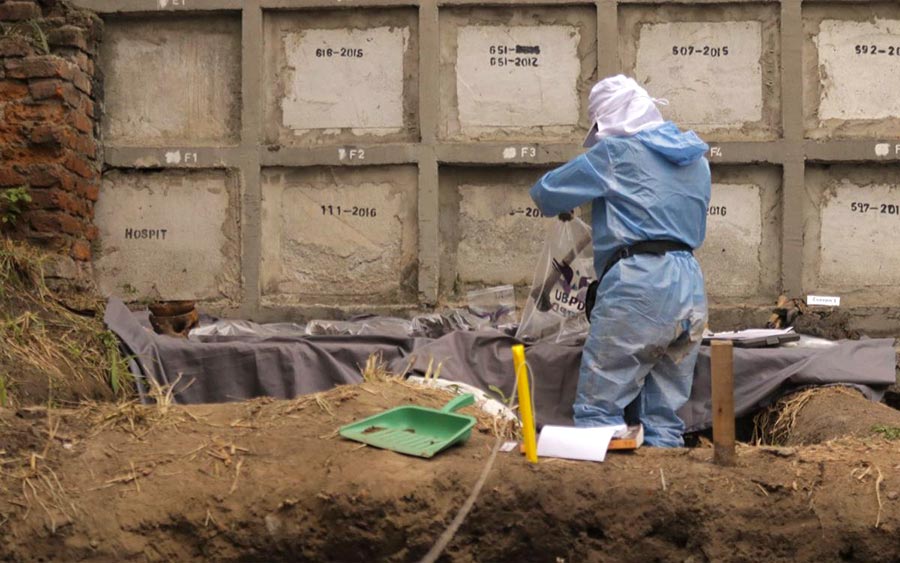
In this cemetery, human remains were kept for years in undignified conditions in the back yard, amid garbage and rubble. Defendants, assuming their ethical and legal responsibilities, transformed it into a memory and truth site, working together with victims. During the late August hand-over event, Harvey Suárez, the JEP technical secretary, acknowledged the significance of this project by saying it represents more than a “reparative initiative”: it is “a true reparative act that the JEP has accompanied,” he said, adding that “transformation does not occur in prison, but in places like this, places of death [that] are changed into places of life” through the joint efforts of victims and authors of the crimes. The JEP, in his view, functions as an enabler in such work, as it amplifies the chances of positive outcomes, as exemplified by the two bodies recovered on the site and returned to their relatives.
The JEP has issued multiple Sentencias interpretativas (Senit) [Interpretative rulings] that some deem fundamental to ensuring legal clarity and consistency as it approaches sentencing. For instance, in 2023, Senit 5 ruling clarified who may be considered to have had a determining role in the crimes and the JEP unit that makes this decision. Only members of the senior leadership of the FARC, high ranking members of the security forces, or state agents with a decisive role in the criminal structures and processes shaping systematic victimization during the conflict belong to this category. Further, Senit 8 ruling established rules for other categories of perpetrators involved in restorative projects, especially in terms of the conditionality regime and clarified that victim participation must be meaningful in relation to reparation.
Well-intentioned as these procedural clarifications may have been, the transition between them can also cause difficulties. For example, the changes in requirements introduced by Senit 8 prompted the Comité de Reconciliación to pivot midway through a project, leading to frustration, lost time and wasted resources. Despite the clarity gained in recent years, public officials involved in existing restorative projects pointed out that upcoming sentencing may still be affected by the lack of a unified and accepted theory of change by which to measure outcomes across the 11 macro-cases.
Bureaucratic hurdles
Like many such large innovative policy initiatives, the implementation of restorative projects is disrupted by bureaucratic hurdles: slow administrative procedures, poor coordination and communication between institutions, frequent leadership changes, and changing requirements. Many of these challenges stem from the great number of institutions and civil society organizations operating the peacebuilding sector. For instance, all work in Horizontes Seguros involved some measure of cooperation between the JEP, the CCCM, the Victim’s Unit, and the ministry of defence, and their respective mandates and responsibilities were not always clear. Duplication of work, frustration, and lack of legal and security guarantees have been highlighted as the foremost challenges in restorative projects.
The lack of agreement between the magistrates responsible for different macro-cases, and the absence of a JEP-wide standard for how defendants’ participation will count towards their sentencing, affects negatively the likelihood of participation. To illustrate, while truth is part of defendants’ obligations under the conditionality regime, the JEP also approved some restorative projects on the search for the disappeared such as the one in Palmira. This creates confusion about whether and to what extent this work will be considered in sentencing. León, of the Reencuentros lamented such ambiguities, stressing that time is of the essence especially in cases of disappearance. Other participants are hesitant to participate in anticipated projects because they were no longer serving time in prison when they approached the JEP and are unlikely to do so as a result of their sentence, as Major César Maldonado, the spokesperson for Comité de Reconciliación told us.
Security threats
Additional challenges arise from the deterioration of territorial control by the state and continuing security threats. More than 1,500 people associated with the peace process have been assassinated since 2016. In a recent hearing on the restorative projects, the JEP even called attention to how underfunding for humanitarian demining by the current administration has affected security for civilians. While no deaths have been reported during the implementation of restorative activities, more than 400 FARC ex-combatants have been murdered since signing the peace agreement. These severe security risks create hesitancy and lack of trust in restorative projects’ participants and raise the cost for implementation in certain parts of the country.
Access to many communities involved in the exploratory restorative projects is also often complicated, time-consuming, and expensive, with reliance on everything from small charter flights and private armoured vehicles to mules. Restorative projects whose outcomes are physical creations, such as memory exhibits or environmental interventions, require continuous security and maintenance to avoid vandalism or deterioration, but local governments have been reluctant to become involved.
While many local authorities understandably argue their funding was overstretched -even before certain sites in their jurisdictions were chosen for restorative projects-, lack of aftercare for the work completed not only risks their sustainability, but may also affect defendants’ sentencing outcomes. Without clearer and more effective planning and commitment from institutional partners, rising security costs are likely to end up being shouldered by international donors.
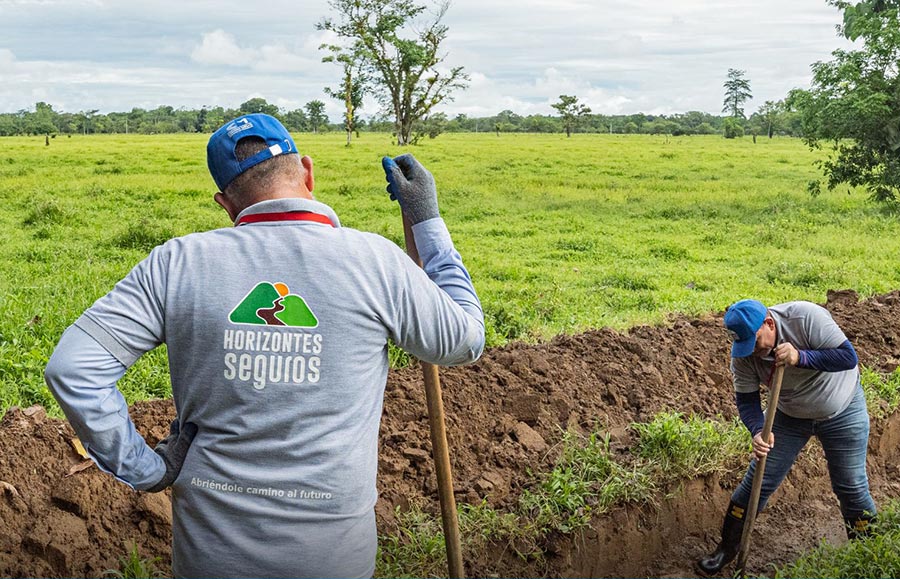
Political tensions and upcoming elections
Political pressures, historical and present, and tensions between elected public officials and the JEP add further complications. While they were certainly more vocal during the Duque administration, conservative and right-wing sectors of society continue to criticize the JEP as too costly, slow, and biased against state agents. Initially an avid supporter of the peace agreement, the Petro administration’s focus on its “Total Peace” policy has diverted attention and economic support from older transitional justice institutions, which affects the JEP’s general capacity to deliver critical advances.
The JEP budget, which supports some restorative projects, is allocated through the yearly national general budget approved by congress. Conflicts between the legislative and executive branches’ political agendas and visions of the future of the country impact this process, delaying or even reducing available resources for the final peace agreement. Alarm bells are going off domestically as congress rejected the proposed budget for 2025, resulting in it being pushed through via decree by the executive. A variety of aspects relating to transitional justice are seriously underfunded as of this year, and the comptrollership, an institution dedicated to financial oversight, has already rung the alarm about the risks as the JEP approaches the sentencing phase. With congressional and presidential elections due to take place in March and May 2026 respectively, the future of the JEP and its funding is likely to be determined by a new balance of political forces, as the electorate will not go easy on this administration’s centre-left coalition.
The need for international funding
This potential volatility demonstrates further necessity for outside support and funding for the JEP and the restorative projects. The voluntary labour of participants and some donated materials reduce direct costs, but expenses associated with project design, monitoring, security, and transportation remain high. The three exploratory restorative projects already approved by the JEP were funded by the United Nations Trust fund for sustaining peace in Colombia, while other initiatives received support from foreign governments, some indirectly through the implementing civil society organizations. Nos juntamos para encontrarles, which delivered the project in Palmira, was funded by the United Nations Development Program (UNDP), Sweden and Germany.
The demise of USAID, which supported the largest foreign contributions to peacebuilding since the final peace agreement, left many of those in the sector scrambling. The European Union contributes to the implementation of the agreement through its European trust fund for Colombia and, although the EU Ambassador to Colombia has recently expanded this fund to fill some of the gap left by USAID, he also made a statement on the limitations of their budget. This deficit could pose problems to the sustainability of restorative projects and other justice initiatives, especially in light of the Petro administration’s difficulties to fund its government program.
The JEP’s first few years of operations were dominated by funding concerns and clashes with the Duque administration and its representatives. Memories of JEP-bashing by the Duque administration, whose key electoral promise was to dismantle the peace agreement, have been revived in the last couple of months by the right wing.
While general elections are less than a year away, the Democratic Centre, the main political party to oppose the peace agreement, has already lost one of its presidential hopefuls to an assassination and had its founder sentenced in trial court. This has put enmity against the JEP and the FARC back on the political agenda, with renewed discussions around reducing its funding and accusations of “legal asymmetry”.
This week, as the JEP hands out its first sentences, the main issue is which lessons, if any, will be learned from existing restorative projects. The risk is that the great promise of the peace agreement comes to naught and the restorative approach of the JEP ends up joining the pile of good intentions.

Abigail Herrada is a senior student at the College of William and Mary, studying Psychology and Global Studies with a concentration in Latin America. Her fieldwork in Colombia, Guatemala, and Argentina has focused on issues of restorative justice, community development, and human rights.

Meghan Velotas is a fourth-year student of International Relations and Hispanic Studies at the College of William and Mary and University of St. Andrews BA International Honours Programme. Her areas of academic and professional interest include diplomacy, international human rights and conflict resolution.
The research for this entry was supported by funding from the Global Research Institute at William & Mary through its Global Summer Fellows Program. The fieldwork stay was organized by Adriana Rudling, a Post-doctoral Fellow – Transitional Justice at the Global Research Institute. We want to thank all our interviewees and participants for their time and invaluable insights.


